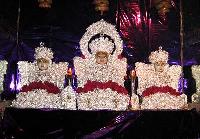
Temples
We have carved a niche as one of the most prominent pure Gold & Silver Varakh (foil/leaf) manufacturers in India. The gold & silver varakh is cent percent vegetarian and hence does not offend the rituals of any religion. In the manufacturing process of the vegetarian gold & silver varakh, there is neither human touch nor any animal derived substance are used. This varakh/foil/leaf is widely used in confectionery industry to decorate the sweet and make them suitable for various occasions. The cost of the vegetarian varakh is quite reasonable. Introduction to traditional Gold & Silver Varakh Gold/ Silver foil (leaf), or varakh, as it is generally known in India, adds glitter to Indian sweets, supari, paan, and fruits. It is also used in Ayurvedic medicines and on deities in many Jain temples. The silver-topped sweet is even served as 'prasad' in temples and on auspicious and religious as well as family and social occasions. Varakh is used in flavored syrups as in kesar (saffron) syrup, and also finds use in cosmetics. Do you know whether the varakh (gold and silver foil) used in many Jain temples on the idols and in some religious ceremonies is vegetarian? Do you know how the varakh on your sweets (mithai) is manufactured? As a child I remember always asking for those sweets that had silver foil on them. Even today children as well as adults go for varakh on the sweets. Its popular appeal has a stronger hold on people's mind, increasing the demand and there by it's supply. If people know the source and method of making it, I am sure they will never eat the silver-coated sweets again. If you look beyond the glitter of varakh, into the sheds where it is produced, and at the lives that are sacrificed to make this possible, you would think twice before buying these Silver/Gold Foil. The ox is killed in the abattoirs; its intestines are pulled out and sold immediately to the varakh makers. Old intestine can not be used. Even one day old intestine is too old because it losses its elasticity. The intestines are cut into pieces . The pieces are prepared like books and silver or gold sheets are placed between the each skin paper. Then it is kept into a specially made of leather bag. The ox intestine is hammered to make silver or gold sheet (Varakh) which become part of the sweets. The Silver or Gold varakh bought to the market, not only it is a dirty thing to consume but is very shameful that it is being served in temples . How can a Jain use these Silver or Gold Foil for themselves as well as for there GOD�s ? �Varakh is not derived from animal sources. However, a crucial material of animal origin, ox-gut, is used in its manufacture. This ox-gut is obtained from slaughterhouses. Small thin strips of silver are placed between this Ox-gut and are hammered to produce the glittering foil.� (Source: www.jainworld.com). 100% Pure & Vegetarian Gold & Silver Varakh (Foil/Leaf) Considering all above we have decided to produce this gold and silver varakh (foil/leaf) in a manner that it should not hurt anyone�s religion belief and hence after long and hard researches we have developed state of art process for making gold and silver varakh in 100% pure and vegetarian way. Procured its complete plant and machinery from Germany. During our complete manufacturing process silver or gold is neither touched by human hands or it is contaminated with any animal products since no any animal products are used in our process and hence varakh produced by us are 100% Vegetarian and Hygeinic.
...more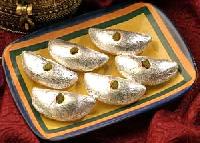
Sweets-1
We have carved a niche as one of the most prominent pure Gold & Silver Varakh (foil/leaf) manufacturers in India. The gold & silver varakh is cent percent vegetarian and hence does not offend the rituals of any religion. In the manufacturing process of the vegetarian gold & silver varakh, there is neither human touch nor any animal derived substance are used. This varakh/foil/leaf is widely used in confectionery industry to decorate the sweet and make them suitable for various occasions. The cost of the vegetarian varakh is quite reasonable. Introduction to traditional Gold & Silver Varakh Gold/ Silver foil (leaf), or varakh, as it is generally known in India, adds glitter to Indian sweets, supari, paan, and fruits. It is also used in Ayurvedic medicines and on deities in many Jain temples. The silver-topped sweet is even served as 'prasad' in temples and on auspicious and religious as well as family and social occasions. Varakh is used in flavored syrups as in kesar (saffron) syrup, and also finds use in cosmetics. Do you know whether the varakh (gold and silver foil) used in many Jain temples on the idols and in some religious ceremonies is vegetarian? Do you know how the varakh on your sweets (mithai) is manufactured? As a child I remember always asking for those sweets that had silver foil on them. Even today children as well as adults go for varakh on the sweets. Its popular appeal has a stronger hold on people's mind, increasing the demand and there by it's supply. If people know the source and method of making it, I am sure they will never eat the silver-coated sweets again. If you look beyond the glitter of varakh, into the sheds where it is produced, and at the lives that are sacrificed to make this possible, you would think twice before buying these Silver/Gold Foil. The ox is killed in the abattoirs; its intestines are pulled out and sold immediately to the varakh makers. Old intestine can not be used. Even one day old intestine is too old because it losses its elasticity. The intestines are cut into pieces . The pieces are prepared like books and silver or gold sheets are placed between the each skin paper. Then it is kept into a specially made of leather bag. The ox intestine is hammered to make silver or gold sheet (Varakh) which become part of the sweets. The Silver or Gold varakh bought to the market, not only it is a dirty thing to consume but is very shameful that it is being served in temples . How can a Jain use these Silver or Gold Foil for themselves as well as for there GOD�s ? �Varakh is not derived from animal sources. However, a crucial material of animal origin, ox-gut, is used in its manufacture. This ox-gut is obtained from slaughterhouses. Small thin strips of silver are placed between this Ox-gut and are hammered to produce the glittering foil.� (Source: www.jainworld.com). 100% Pure & Vegetarian Gold & Silver Varakh (Foil/Leaf) Considering all above we have decided to produce this gold and silver varakh (foil/leaf) in a manner that it should not hurt anyone�s religion belief and hence after long and hard researches we have developed state of art process for making gold and silver varakh in 100% pure and vegetarian way. Procured its complete plant and machinery from Germany. During our complete manufacturing process silver or gold is neither touched by human hands or it is contaminated with any animal products since no any animal products are used in our process and hence varakh produced by us are 100% Vegetarian and Hygeinic.
...more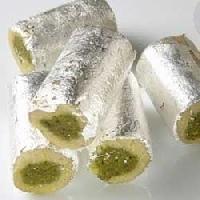
Silver varakh
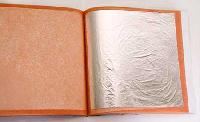
Silver Leaf
We have carved a niche as one of the most prominent pure Gold & Silver Varakh (foil/leaf) manufacturers in India. The gold & silver varakh is cent percent vegetarian and hence does not offend the rituals of any religion. In the manufacturing process of the vegetarian gold & silver varakh, there is neither human touch nor any animal derived substance are used. This varakh/foil/leaf is widely used in confectionery industry to decorate the sweet and make them suitable for various occasions. The cost of the vegetarian varakh is quite reasonable. Introduction to traditional Gold & Silver Varakh Gold/ Silver foil (leaf), or varakh, as it is generally known in India, adds glitter to Indian sweets, supari, paan, and fruits. It is also used in Ayurvedic medicines and on deities in many Jain temples. The silver-topped sweet is even served as 'prasad' in temples and on auspicious and religious as well as family and social occasions. Varakh is used in flavored syrups as in kesar (saffron) syrup, and also finds use in cosmetics. Do you know whether the varakh (gold and silver foil) used in many Jain temples on the idols and in some religious ceremonies is vegetarian? Do you know how the varakh on your sweets (mithai) is manufactured? As a child I remember always asking for those sweets that had silver foil on them. Even today children as well as adults go for varakh on the sweets. Its popular appeal has a stronger hold on people's mind, increasing the demand and there by it's supply. If people know the source and method of making it, I am sure they will never eat the silver-coated sweets again. If you look beyond the glitter of varakh, into the sheds where it is produced, and at the lives that are sacrificed to make this possible, you would think twice before buying these Silver/Gold Foil. The ox is killed in the abattoirs; its intestines are pulled out and sold immediately to the varakh makers. Old intestine can not be used. Even one day old intestine is too old because it losses its elasticity. The intestines are cut into pieces . The pieces are prepared like books and silver or gold sheets are placed between the each skin paper. Then it is kept into a specially made of leather bag. The ox intestine is hammered to make silver or gold sheet (Varakh) which become part of the sweets. The Silver or Gold varakh bought to the market, not only it is a dirty thing to consume but is very shameful that it is being served in temples . How can a Jain use these Silver or Gold Foil for themselves as well as for there GOD�s ? �Varakh is not derived from animal sources. However, a crucial material of animal origin, ox-gut, is used in its manufacture. This ox-gut is obtained from slaughterhouses. Small thin strips of silver are placed between this Ox-gut and are hammered to produce the glittering foil.� (Source: www.jainworld.com). 100% Pure & Vegetarian Gold & Silver Varakh (Foil/Leaf) Considering all above we have decided to produce this gold and silver varakh (foil/leaf) in a manner that it should not hurt anyone�s religion belief and hence after long and hard researches we have developed state of art process for making gold and silver varakh in 100% pure and vegetarian way. Procured its complete plant and machinery from Germany. During our complete manufacturing process silver or gold is neither touched by human hands or it is contaminated with any animal products since no any animal products are used in our process and hence varakh produced by us are 100% Vegetarian and Hygeinic.
...more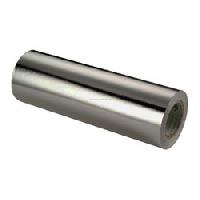
Silver Foil
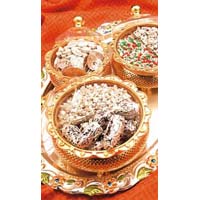
Mouth Freshners
We have carved a niche as one of the most prominent pure Gold & Silver Varakh (foil/leaf) manufacturers in India. The gold & silver varakh is cent percent vegetarian and hence does not offend the rituals of any religion. In the manufacturing process of the vegetarian gold & silver varakh, there is neither human touch nor any animal derived substance are used. This varakh/foil/leaf is widely used in confectionery industry to decorate the sweet and make them suitable for various occasions. The cost of the vegetarian varakh is quite reasonable. Introduction to traditional Gold & Silver Varakh Gold/ Silver foil (leaf), or varakh, as it is generally known in India, adds glitter to Indian sweets, supari, paan, and fruits. It is also used in Ayurvedic medicines and on deities in many Jain temples. The silver-topped sweet is even served as 'prasad' in temples and on auspicious and religious as well as family and social occasions. Varakh is used in flavored syrups as in kesar (saffron) syrup, and also finds use in cosmetics. Do you know whether the varakh (gold and silver foil) used in many Jain temples on the idols and in some religious ceremonies is vegetarian? Do you know how the varakh on your sweets (mithai) is manufactured? As a child I remember always asking for those sweets that had silver foil on them. Even today children as well as adults go for varakh on the sweets. Its popular appeal has a stronger hold on people's mind, increasing the demand and there by it's supply. If people know the source and method of making it, I am sure they will never eat the silver-coated sweets again. If you look beyond the glitter of varakh, into the sheds where it is produced, and at the lives that are sacrificed to make this possible, you would think twice before buying these Silver/Gold Foil. The ox is killed in the abattoirs; its intestines are pulled out and sold immediately to the varakh makers. Old intestine can not be used. Even one day old intestine is too old because it losses its elasticity. The intestines are cut into pieces . The pieces are prepared like books and silver or gold sheets are placed between the each skin paper. Then it is kept into a specially made of leather bag. The ox intestine is hammered to make silver or gold sheet (Varakh) which become part of the sweets. The Silver or Gold varakh bought to the market, not only it is a dirty thing to consume but is very shameful that it is being served in temples . How can a Jain use these Silver or Gold Foil for themselves as well as for there GOD�s ? �Varakh is not derived from animal sources. However, a crucial material of animal origin, ox-gut, is used in its manufacture. This ox-gut is obtained from slaughterhouses. Small thin strips of silver are placed between this Ox-gut and are hammered to produce the glittering foil.� (Source: www.jainworld.com). 100% Pure & Vegetarian Gold & Silver Varakh (Foil/Leaf) Considering all above we have decided to produce this gold and silver varakh (foil/leaf) in a manner that it should not hurt anyone�s religion belief and hence after long and hard researches we have developed state of art process for making gold and silver varakh in 100% pure and vegetarian way. Procured its complete plant and machinery from Germany. During our complete manufacturing process silver or gold is neither touched by human hands or it is contaminated with any animal products since no any animal products are used in our process and hence varakh produced by us are 100% Vegetarian and Hygeinic.
...more
Mithai
We have carved a niche as one of the most prominent pure Gold & Silver Varakh (foil/leaf) manufacturers in India. The gold & silver varakh is cent percent vegetarian and hence does not offend the rituals of any religion. In the manufacturing process of the vegetarian gold & silver varakh, there is neither human touch nor any animal derived substance are used. This varakh/foil/leaf is widely used in confectionery industry to decorate the sweet and make them suitable for various occasions. The cost of the vegetarian varakh is quite reasonable. Introduction to traditional Gold & Silver Varakh Gold/ Silver foil (leaf), or varakh, as it is generally known in India, adds glitter to Indian sweets, supari, paan, and fruits. It is also used in Ayurvedic medicines and on deities in many Jain temples. The silver-topped sweet is even served as 'prasad' in temples and on auspicious and religious as well as family and social occasions. Varakh is used in flavored syrups as in kesar (saffron) syrup, and also finds use in cosmetics. Do you know whether the varakh (gold and silver foil) used in many Jain temples on the idols and in some religious ceremonies is vegetarian? Do you know how the varakh on your sweets (mithai) is manufactured? As a child I remember always asking for those sweets that had silver foil on them. Even today children as well as adults go for varakh on the sweets. Its popular appeal has a stronger hold on people's mind, increasing the demand and there by it's supply. If people know the source and method of making it, I am sure they will never eat the silver-coated sweets again. If you look beyond the glitter of varakh, into the sheds where it is produced, and at the lives that are sacrificed to make this possible, you would think twice before buying these Silver/Gold Foil. The ox is killed in the abattoirs; its intestines are pulled out and sold immediately to the varakh makers. Old intestine can not be used. Even one day old intestine is too old because it losses its elasticity. The intestines are cut into pieces . The pieces are prepared like books and silver or gold sheets are placed between the each skin paper. Then it is kept into a specially made of leather bag. The ox intestine is hammered to make silver or gold sheet (Varakh) which become part of the sweets. The Silver or Gold varakh bought to the market, not only it is a dirty thing to consume but is very shameful that it is being served in temples . How can a Jain use these Silver or Gold Foil for themselves as well as for there GOD�s ? �Varakh is not derived from animal sources. However, a crucial material of animal origin, ox-gut, is used in its manufacture. This ox-gut is obtained from slaughterhouses. Small thin strips of silver are placed between this Ox-gut and are hammered to produce the glittering foil.� (Source: www.jainworld.com). 100% Pure & Vegetarian Gold & Silver Varakh (Foil/Leaf) Considering all above we have decided to produce this gold and silver varakh (foil/leaf) in a manner that it should not hurt anyone�s religion belief and hence after long and hard researches we have developed state of art process for making gold and silver varakh in 100% pure and vegetarian way. Procured its complete plant and machinery from Germany. During our complete manufacturing process silver or gold is neither touched by human hands or it is contaminated with any animal products since no any animal products are used in our process and hence varakh produced by us are 100% Vegetarian and Hygeinic.
...more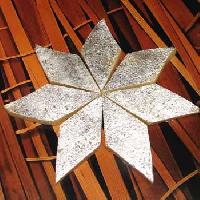
Kaju Katri Silver
We have carved a niche as one of the most prominent pure Gold & Silver Varakh (foil/leaf) manufacturers in India. The gold & silver varakh is cent percent vegetarian and hence does not offend the rituals of any religion. In the manufacturing process of the vegetarian gold & silver varakh, there is neither human touch nor any animal derived substance are used. This varakh/foil/leaf is widely used in confectionery industry to decorate the sweet and make them suitable for various occasions. The cost of the vegetarian varakh is quite reasonable. Introduction to traditional Gold & Silver Varakh Gold/ Silver foil (leaf), or varakh, as it is generally known in India, adds glitter to Indian sweets, supari, paan, and fruits. It is also used in Ayurvedic medicines and on deities in many Jain temples. The silver-topped sweet is even served as 'prasad' in temples and on auspicious and religious as well as family and social occasions. Varakh is used in flavored syrups as in kesar (saffron) syrup, and also finds use in cosmetics. Do you know whether the varakh (gold and silver foil) used in many Jain temples on the idols and in some religious ceremonies is vegetarian? Do you know how the varakh on your sweets (mithai) is manufactured? As a child I remember always asking for those sweets that had silver foil on them. Even today children as well as adults go for varakh on the sweets. Its popular appeal has a stronger hold on people's mind, increasing the demand and there by it's supply. If people know the source and method of making it, I am sure they will never eat the silver-coated sweets again. If you look beyond the glitter of varakh, into the sheds where it is produced, and at the lives that are sacrificed to make this possible, you would think twice before buying these Silver/Gold Foil. The ox is killed in the abattoirs; its intestines are pulled out and sold immediately to the varakh makers. Old intestine can not be used. Even one day old intestine is too old because it losses its elasticity. The intestines are cut into pieces . The pieces are prepared like books and silver or gold sheets are placed between the each skin paper. Then it is kept into a specially made of leather bag. The ox intestine is hammered to make silver or gold sheet (Varakh) which become part of the sweets. The Silver or Gold varakh bought to the market, not only it is a dirty thing to consume but is very shameful that it is being served in temples . How can a Jain use these Silver or Gold Foil for themselves as well as for there GOD�s ? �Varakh is not derived from animal sources. However, a crucial material of animal origin, ox-gut, is used in its manufacture. This ox-gut is obtained from slaughterhouses. Small thin strips of silver are placed between this Ox-gut and are hammered to produce the glittering foil.� (Source: www.jainworld.com). 100% Pure & Vegetarian Gold & Silver Varakh (Foil/Leaf) Considering all above we have decided to produce this gold and silver varakh (foil/leaf) in a manner that it should not hurt anyone�s religion belief and hence after long and hard researches we have developed state of art process for making gold and silver varakh in 100% pure and vegetarian way. Procured its complete plant and machinery from Germany. During our complete manufacturing process silver or gold is neither touched by human hands or it is contaminated with any animal products since no any animal products are used in our process and hence varakh produced by us are 100% Vegetarian and Hygeinic.
...more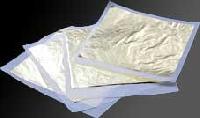
Gold Foil
We have carved a niche as one of the most prominent pure Gold & Silver Varakh (foil/leaf) manufacturers in India. The gold & silver varakh is cent percent vegetarian and hence does not offend the rituals of any religion. In the manufacturing process of the vegetarian gold & silver varakh, there is neither human touch nor any animal derived substance are used. This varakh/foil/leaf is widely used in confectionery industry to decorate the sweet and make them suitable for various occasions. The cost of the vegetarian varakh is quite reasonable. Introduction to traditional Gold & Silver Varakh Gold/ Silver foil (leaf), or varakh, as it is generally known in India, adds glitter to Indian sweets, supari, paan, and fruits. It is also used in Ayurvedic medicines and on deities in many Jain temples. The silver-topped sweet is even served as 'prasad' in temples and on auspicious and religious as well as family and social occasions. Varakh is used in flavored syrups as in kesar (saffron) syrup, and also finds use in cosmetics. Do you know whether the varakh (gold and silver foil) used in many Jain temples on the idols and in some religious ceremonies is vegetarian? Do you know how the varakh on your sweets (mithai) is manufactured? As a child I remember always asking for those sweets that had silver foil on them. Even today children as well as adults go for varakh on the sweets. Its popular appeal has a stronger hold on people's mind, increasing the demand and there by it's supply. If people know the source and method of making it, I am sure they will never eat the silver-coated sweets again. If you look beyond the glitter of varakh, into the sheds where it is produced, and at the lives that are sacrificed to make this possible, you would think twice before buying these Silver/Gold Foil. The ox is killed in the abattoirs; its intestines are pulled out and sold immediately to the varakh makers. Old intestine can not be used. Even one day old intestine is too old because it losses its elasticity. The intestines are cut into pieces . The pieces are prepared like books and silver or gold sheets are placed between the each skin paper. Then it is kept into a specially made of leather bag. The ox intestine is hammered to make silver or gold sheet (Varakh) which become part of the sweets. The Silver or Gold varakh bought to the market, not only it is a dirty thing to consume but is very shameful that it is being served in temples . How can a Jain use these Silver or Gold Foil for themselves as well as for there GOD�s ? �Varakh is not derived from animal sources. However, a crucial material of animal origin, ox-gut, is used in its manufacture. This ox-gut is obtained from slaughterhouses. Small thin strips of silver are placed between this Ox-gut and are hammered to produce the glittering foil.� (Source: www.jainworld.com). 100% Pure & Vegetarian Gold & Silver Varakh (Foil/Leaf) Considering all above we have decided to produce this gold and silver varakh (foil/leaf) in a manner that it should not hurt anyone�s religion belief and hence after long and hard researches we have developed state of art process for making gold and silver varakh in 100% pure and vegetarian way. Procured its complete plant and machinery from Germany. During our complete manufacturing process silver or gold is neither touched by human hands or it is contaminated with any animal products since no any animal products are used in our process and hence varakh produced by us are 100% Vegetarian and Hygeinic.
...more
Edible Gold Banner-2
We have carved a niche as one of the most prominent pure Gold & Silver Varakh (foil/leaf) manufacturers in India. The gold & silver varakh is cent percent vegetarian and hence does not offend the rituals of any religion. In the manufacturing process of the vegetarian gold & silver varakh, there is neither human touch nor any animal derived substance are used. This varakh/foil/leaf is widely used in confectionery industry to decorate the sweet and make them suitable for various occasions. The cost of the vegetarian varakh is quite reasonable. Introduction to traditional Gold & Silver Varakh Gold/ Silver foil (leaf), or varakh, as it is generally known in India, adds glitter to Indian sweets, supari, paan, and fruits. It is also used in Ayurvedic medicines and on deities in many Jain temples. The silver-topped sweet is even served as 'prasad' in temples and on auspicious and religious as well as family and social occasions. Varakh is used in flavored syrups as in kesar (saffron) syrup, and also finds use in cosmetics. Do you know whether the varakh (gold and silver foil) used in many Jain temples on the idols and in some religious ceremonies is vegetarian? Do you know how the varakh on your sweets (mithai) is manufactured? As a child I remember always asking for those sweets that had silver foil on them. Even today children as well as adults go for varakh on the sweets. Its popular appeal has a stronger hold on people's mind, increasing the demand and there by it's supply. If people know the source and method of making it, I am sure they will never eat the silver-coated sweets again. If you look beyond the glitter of varakh, into the sheds where it is produced, and at the lives that are sacrificed to make this possible, you would think twice before buying these Silver/Gold Foil. The ox is killed in the abattoirs; its intestines are pulled out and sold immediately to the varakh makers. Old intestine can not be used. Even one day old intestine is too old because it losses its elasticity. The intestines are cut into pieces . The pieces are prepared like books and silver or gold sheets are placed between the each skin paper. Then it is kept into a specially made of leather bag. The ox intestine is hammered to make silver or gold sheet (Varakh) which become part of the sweets. The Silver or Gold varakh bought to the market, not only it is a dirty thing to consume but is very shameful that it is being served in temples . How can a Jain use these Silver or Gold Foil for themselves as well as for there GOD�s ? �Varakh is not derived from animal sources. However, a crucial material of animal origin, ox-gut, is used in its manufacture. This ox-gut is obtained from slaughterhouses. Small thin strips of silver are placed between this Ox-gut and are hammered to produce the glittering foil.� (Source: www.jainworld.com). 100% Pure & Vegetarian Gold & Silver Varakh (Foil/Leaf) Considering all above we have decided to produce this gold and silver varakh (foil/leaf) in a manner that it should not hurt anyone�s religion belief and hence after long and hard researches we have developed state of art process for making gold and silver varakh in 100% pure and vegetarian way. Procured its complete plant and machinery from Germany. During our complete manufacturing process silver or gold is neither touched by human hands or it is contaminated with any animal products since no any animal products are used in our process and hence varakh produced by us are 100% Vegetarian and Hygeinic.
...more
Banner-1
We have carved a niche as one of the most prominent pure Gold & Silver Varakh (foil/leaf) manufacturers in India. The gold & silver varakh is cent percent vegetarian and hence does not offend the rituals of any religion. In the manufacturing process of the vegetarian gold & silver varakh, there is neither human touch nor any animal derived substance are used. This varakh/foil/leaf is widely used in confectionery industry to decorate the sweet and make them suitable for various occasions. The cost of the vegetarian varakh is quite reasonable. Introduction to traditional Gold & Silver Varakh Gold/ Silver foil (leaf), or varakh, as it is generally known in India, adds glitter to Indian sweets, supari, paan, and fruits. It is also used in Ayurvedic medicines and on deities in many Jain temples. The silver-topped sweet is even served as 'prasad' in temples and on auspicious and religious as well as family and social occasions. Varakh is used in flavored syrups as in kesar (saffron) syrup, and also finds use in cosmetics. Do you know whether the varakh (gold and silver foil) used in many Jain temples on the idols and in some religious ceremonies is vegetarian? Do you know how the varakh on your sweets (mithai) is manufactured? As a child I remember always asking for those sweets that had silver foil on them. Even today children as well as adults go for varakh on the sweets. Its popular appeal has a stronger hold on people's mind, increasing the demand and there by it's supply. If people know the source and method of making it, I am sure they will never eat the silver-coated sweets again. If you look beyond the glitter of varakh, into the sheds where it is produced, and at the lives that are sacrificed to make this possible, you would think twice before buying these Silver/Gold Foil. The ox is killed in the abattoirs; its intestines are pulled out and sold immediately to the varakh makers. Old intestine can not be used. Even one day old intestine is too old because it losses its elasticity. The intestines are cut into pieces . The pieces are prepared like books and silver or gold sheets are placed between the each skin paper. Then it is kept into a specially made of leather bag. The ox intestine is hammered to make silver or gold sheet (Varakh) which become part of the sweets. The Silver or Gold varakh bought to the market, not only it is a dirty thing to consume but is very shameful that it is being served in temples . How can a Jain use these Silver or Gold Foil for themselves as well as for there GOD�s ? �Varakh is not derived from animal sources. However, a crucial material of animal origin, ox-gut, is used in its manufacture. This ox-gut is obtained from slaughterhouses. Small thin strips of silver are placed between this Ox-gut and are hammered to produce the glittering foil.� (Source: www.jainworld.com). 100% Pure & Vegetarian Gold & Silver Varakh (Foil/Leaf) Considering all above we have decided to produce this gold and silver varakh (foil/leaf) in a manner that it should not hurt anyone�s religion belief and hence after long and hard researches we have developed state of art process for making gold and silver varakh in 100% pure and vegetarian way. Procured its complete plant and machinery from Germany. During our complete manufacturing process silver or gold is neither touched by human hands or it is contaminated with any animal products since no any animal products are used in our process and hence varakh produced by us are 100% Vegetarian and Hygeinic.
...more
milk khoya
Our company is reckoned as the outstanding pure Khoa (Mawa) manufacturer and supplier in India. The Khoa (Mawa) manufactured by our enterprise is hygienic and pure as we use milk of cow or buffalo. Moreover, the quality of the milk Khoa (Mawa) is as per the Indian Standard Specification given in IS 4883, 1968. The Khoa (Mawa) is available in three categories that are pindi, dhap and danedar. The Khoa (Mawa) is ordered in bulk by our customers as these are used to make sweets for various auspicious occasions. Pure & Hygienic Mawa (Khoa) Introduction Khoa constitutes one of the two chief bases (the other being chhana) for preparing indigenous sweets. The production of khoa in India in 1966 was estimated to be about 4.9 % of total dairy production and 8.7 % of the milk used for manufacture of milk products. Today, the total khoa production may be estimated at over 300 million kg., valued at Rs 300 crores at the present rates. The preparation and use of khoa are confined mostly to the northern and western regions of the country. By far the largest amount is contributed by Uttar Pradesh, where nearly 36 percent of the country�s total khoa production takes place. Definition Khoa / Khava / Mawa refers to the partially dehydrated whole milk product prepared by the continuous heating of milk in a karahi over a direct fire, while also constantly stirring cum-scraping by using a khunti till it reaches a semi-solid (doughy) consistency. Thereafter, the pan-contents are removed from the fire and worked up into a solid mass known as khoa-pat According to the PFA Rules (1976), khoa is the product obtained from cow or buffalo (or goat or sheep) milk, or a combination thereof, by rapid drying. The milk fat content should not be less than 20 % of the finished product. (The Indian Standard Specification for khoa is given in IS 4883, 1968)(From Wikipedia, the free encyclopedia) Khoa or khoya or khawa or mawa is a dried whole milk or milk thickened by heating milk in an open iron pan. It is similar to ricotta cheese, but lower in moisture and made from whole milk instead of whey. Classification Three main types/varieties of khoa, viz., Pindi - Batti ka khoya - Batti, meaning �rock,� has about 35% moisture by weight and is the hardest of the three types; it can be grated like cheese. It can be aged for up to a year, during which it develops a unique aroma and a mouldy outer surface. This khoya is used in burfies and laddus. Dhap - Daab ka (or chikna) khoya- Chickna (�slippery� or �squishy�) khoya has 44% moisture. This is made with low fat buffalo milk. It is loose and sticky in consistency with a higher moisture content. It is suitable for making gulab-jamuns and gajar ka halwa. Danedar - Danedar (or granulated) khoya-For daan-e-daar, the milk is coagulated with an acid during the simmering and has moderate moisture content. This khoya is made out of full cream buffalo milk. The difference is that khoya is curdled slightly by adding little tartary in powder form. The milk curdles slightly hence the khoya is soft textured. The water content (40%) is more than batti ka khoya but less than the chikna khoya. This type is used in making kalakand and laddu.
Country of Origin : India
Type : Fresh Milk Khoya
Application : Making Sweets
Feature : Fresh
...more
Gold Varakh

vegetarian gold foil
Be first to Rate
Rate ThisOpening Hours